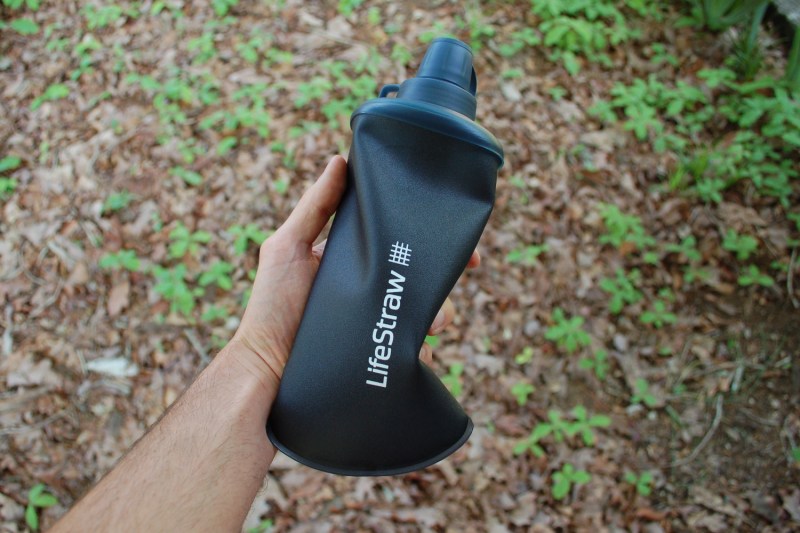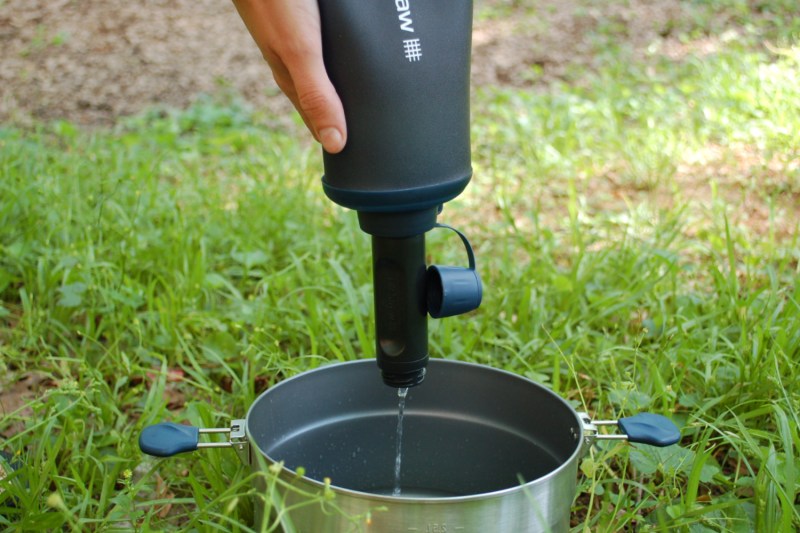Filtering water in the backcountry can be a serious chore, and if you’ve never had the pleasure of painstakingly squeezing water from one container to another one liter at a time, I cordially invite you to try it at home and let me know what you think. That very reason is why I was excited to see that the new Lifestraw Peak Series line of water filtration devices includes a pair of collapsible water bottles, each with its own compact internal filter. One device to rule them all…
- What Is the Lifestraw Peak Series Collapsible Water Bottle?
- How Do They Work?
- What Are the Features of The Lifestraw Peak Series Collapsible Water Bottle?
- What I Like About The Lifestraw Peak Series Bottles
- What I Don’t Like About The Lifestraw Peak Series Bottles
- FAQs About The Lifestraw Peak Series
- Should You Buy a Lifestraw Peak Series Collapsible Bottle?
I’ve put these bottles to good use on my last several camping, hiking, and trail running excursions, and was impressed enough by their outright versatility to share my findings with our esteemed readership. Long story short, I think these bottles make a great addition to just about any traveler and/or outdoorsman’s gear collection, and here’s why.

What Is the Lifestraw Peak Series Collapsible Water Bottle?
The Lifestraw Peak Series collapsible water bottle is a flexible water bottle with a built-in water filtration system that removes harmful bacteria, parasites, and microplastics from drinking water. They come in both 650ml and 1L sizes, and feature compact and modular filters designed to work with other products in the Peak Series line as well as standard disposable water bottles.
The bottles are a versatile solution for anyone who needs to filter sketchy or potentially untreated water. That includes hikers, backpackers, and trail runners who need to gather water from rivers and streams in the backcountry as well as travelers in countries whose water may contain harmful bacteria and protozoa (if you’ve ever experienced Montezuma’s Revenge firsthand, you know what I’m getting at here). The collapsible nature of the bottles themselves makes them more portable and packable than standard reusable bottles from folks like Nalgene or Miir, yet their durable construction is much more tear and puncture-resistant than your average collapsible bottle.
How Do They Work?
These Lifestraw bottles filter all manners of nastiness out of drinking water using a membrane microfilter, which removes particles down to as small as 0.2 microns with over 99.99% efficiency. Because these bottles use a flexible membrane rather than hard plastic or aluminum, they can also be folded down and stowed away between refills or when not in use.
Both sizes feature Lifestraw’s new compact filter, which measures just over 3 x 1 inches. The filter is small enough to leave inside the bottle for simple drinking on the go, but can also be attached to the bottle externally and used as a “squeeze” system for any number of outdoors applications like filling up a cooking pot or refilling secondary reservoirs for longer stretches.

What Are the Features of The Lifestraw Peak Series Collapsible Water Bottle?
- Flows up to 3 liters of water per minute
- Highly durable and puncture/tear-resistant
- Modular filter system works inside or outside bottle
- Compatible with other standard water bottles (Smartwater, etc.)
- Filters 99.999999% of all bacteria including salmonella dn E.coli
- Filters 99.999% of parasites and protozoa
- Filters 99.999% of microplastics
- Each filter treats up to 500 gallons of water
- BPA free
What I Like About The Lifestraw Peak Series Bottles
The New Filter System Is Super Versatile
For me, the value of the new Lifestraw bottles is all about their versatility. For typical day-to-day use, whether it’s running, hiking, traveling, or just staying hydrated, you just fill the bottle as you normally would, then replace the cap and drink straight from the spout. For backpacking purposes, the filter can also be removed from the inside of the bottle, then reattached to the outside, allowing you to filter water into a second reservoir of choice, similar to a Sawyer system. That same filter is also designed to attach directly to any standard wattle bottle (Smart Water folks, I see you), and used as a standalone filtering solution. For me, that means you’re getting a litany of uses out of a single product, which adds serious value.
The Collapsible Bottle Is Insanely Tough
Collapsible water bottles are nothing new, and distance runners have been using them for years with generally good results. Unfortunately collapsible bottles also have a reputation for being somewhat fragile, which doesn’t bode well for backcountry shenanigans. Lifestraw’s new bottles are hilariously tough, and I know that because I tested them by repeatedly throwing them as far as I could down the trail (objective scientific data is a hallmark of good reporting). I was surprised to learn how well these bottles fly, but even more surprised to find that they were in perfect working order every time.
Every Purchase Does Good in the World
One of my favorite things about Lifestraw as a company is its focus on humanitarian work. Lifestraw has been working for years to provide children in need safe drinking water, and for every 500 products they sell, they provide a large-scale purification system to a school, which translates to five years of safe water for 100 kids. Put simply, every product they sell equates to one full year of safe drinking water for one child, and that’s money well spent.
What I Don’t Like About The Lifestraw Peak Series Bottles
The Filters Aren’t the Longest Lasting
Lifestraw’s new Peak Series filters are rated to filter 500 gallons of water before it’s time to replace them. Granted, that means you could use a single Lifestraw filter for every gallon of water you drank for the better part of three years, but there are similarly sized and priced filters out there rated for as much as 100,000 gallons (the equivalent to a lifetime of use). It’s a minor complaint, but one worth pointing out nonetheless.
The Bottles Aren’t Always Pocket-Friendly
If you’ve used collapsible bottles before, you probably know they can be a little awkward to get in and out of pockets due to their lack of structure. Lifestraw’s collapsible bottles can be particularly awkward in that regard because they’re on the wider side (just over 3 inches when filled) and also feature a textured outer surface that’s great for gripping in your hand, but really fights back when you try to stash it in a tight mesh pocket. The bottles were a great addition to my backpacking bag, which has large enough side pockets to easily slide in and out of, but on my smaller day pack and running vests, they were a chore to get in and out.
FAQs About The Lifestraw Peak Series
Do Lifestraw Filters Filter Out Viruses?
Lifestraw Peak Series filters are tested to remove 99.999999% of bacteria, 99.999% of parasites, and 99.999% of microplastics, but they are not rated to filter viruses. That’s industry standard for water filters, and if you want to step up to virus-level filtration, you’ll need to look for a water purifier rather than a water filter.
Are Lifestraw Filters Compatible With Other Systems?
The short answer here is yes, because most all outdoor water filters are designed to work with standard water bottles. That means they all share the same thread design, so you can attach the filter in your Lifestraw collapsible bottle directly to a Sawyer Squeeze bag, Cnoc Vecto, or pretty much any other industry-standard filtration system using the same threaded attachment.
Should You Buy a Lifestraw Peak Series Collapsible Bottle?
I think the Lifestraw Peak Series collapsible bottle is a well-made and impressively versatile piece of gear. In the smaller 650ml size, the bottle works as a great option for trail runners who want to be able to refill out on the trail, travelers who want to avoid foreign bacteria and parasites, or for regular everyday use for anyone who’s concerned about the microplastics in their drinking water. In the larger 1L size, these bottles offer a viable alternative to backpackers who want to ditch disposable plastic options and add versatility to their loadout. Regardless of what you use these bottles for, the fact that they’re affordable and help support a great cause is icing on the cake.
Editors' Recommendations
- A Field Test of the Decathalon Quechua Camp Cookware
- A Beginner’s Guide to Backcountry Navigation
- The 7 Best Water Bottles to Keep You Hydrated in 2022
- The Top 10 Must-Have Stand-Up Paddleboard Accessories for 2022
- Oxo Outdoor, with REI, Is Bringing Elevated Eating to the Outdoors




